HIP DYSPLASIA IN BEAGLES
By Ruth Darlene Stewart
This article was published in the June 2001 edition of the Show Beagle Quarterly. Reproduction of written material and graphics prohibited without permission and credit.
Beagle breeders have often that thought Hip Dysplasia (HD) was not a
problem in beagles because of their small stature. That is
a misconception. While it is agreed that HD in beagles may not be
crippling, if the problem is not addressed and attention given to improving and maintaining
current hip structure, HD may become a crippling problem in the breed.
When do breeders step forward and address the problem? Now? Or when beagles
are lame from hip dysplasia?
Non-show breeders may say it is only in the show stock however, information
obtained from the Beagle Brigade which utilizes beagles from the general
population identifies the number one health reason for rejection of potential
candidates is HD/spinal abnormalities.
Many research articles and theories about HD have been published. The
best information to date is that it is a polygenic trait; meaning more
than one gene pair is involved in the development of HD. Environmental
factors may also play a role in HD, but there has to be a genetic tendency
for the problem. Studies have shown that HD is not present
at birth but gradually develops as the dog matures. "Dysplasia" literally
means "bad development." A dog genetically programmed for HD was
a weakened structural foundation. Many dogs effected with HD may
never show outward signs of lameness, and many times movement cannot be
a diagnostic factor either. Older dogs that show stiffness are said to
have arthritis, but HD is a common cause of arthritis.
There have been less than 300 beagles certified by the Orthopedic Foundation
for Animals (OFA) since 1974. This is a very low number. OFA
records show that of the radiographs being submitted 15% are deemed dysplastic.
Many x-rays may never be submitted because HD is so apparent. If
a larger number of beagles were being submitted for evaluation then the
figures might be more accurately indicative of the overall population.
Many breeders state that they have their dogs checked but do not
submit to OFA. Here are a few reasons to submit to OFA:
1. With the ever-narrowing gene pool it would be a benefit to all breeders
to be able to utilize the OFA records to track certified animals.
This would help in evaluating prospective breeding partners. Only
a handful of breeders can track hip status of their line more than two
generations. If you have your radiographs evaluated by your veterinarian
but not submitted;how will anyone years from now know your dog was normal?
2. OFA evaluation sets a standard that all must meet. Too often
I get breeders telling me that their veterinarian said that the x-rays
were "great" and OFA has a different opinion. General practitioners are
not Board Certified Radiologists. There are Veterinariay Radiologists
that do an OFA type exam, but again, that exam is not on record except
in your personal files. It does nothing to help establish a genetic
database that is accessible to everyone.
3. It is not that expensive. The cost of OFA hip evaluation
is $30.00. Having the radiographs made is the most expensive part.
Miss one weekend of shows and have the x-ray taken, for the betterment
of the breed. OFA also offers discounts for litters and kennels. One way
of decreasing the expense is to have the x-ray taken when the dog is anesthetized
for other reasons. i.e. dental prophy
4. Know from where you are starting. Always consider that
if you get a fair or worse evaluation, you need to look for a breeding
partner with a good or excellent rating.
If you get an evaluation back with HD noted, most experts will
advise you to remove that dog from the breeding population. But,
since there is not an extensive genetic database on beagles regarding HD
and the genetic pool is so limited, some researchers will say to breed
the animal to a partner with better hips. I would caution you on
this endeavor, evaluate your beagle closely. Ask the following questions:
Is it a fine specimen of the breed?
How is the temperment?
How bad is the HD?
Borderlines or mild may be considered carefully for breeding. Avoid breeding animals with moderate or severe
evaluations.
What about other health factors? Thyroid, epilepsy, eye
problems, etc.
Only by selective breeding and consideration of ALL health factors can
breeders hope to improve the breed.
When first delving into the world of HD my veterinarian taught me that
"it is not all ball and socket." Below is a brief overview of the
process of evaluating hips for HD. I am using the OFA method as a
standard due primarily to the fact that is has been used for decades, it
is readily available to all, and provides a tracking database.
The certification number given to a beagle represent the number of beagles
certified, the age in months that the beagle was cleared, and the grade
give (Excellent, Good, Fair). A preliminary evaluation can be obtained
prior to the age of 24 months but permanent certification will only be
given at two years of age or older.
 Figure
1 shows the proper positioning.
Figure
1 shows the proper positioning.
a. Inclusion of the pelvis, femurs and stifles
b. Symmetrical position
1. Equal width of the wings
of the ilia.
2. Equal size of the
obturator foramina
3. Parallel femurs
with the patella
positioned on the midline of the
distal femurs.
OFA will evaluate the following factors:
a. Joint space
b. Amount of femoral head within the
acetabulum. (a minimum 1/2)
c. Shape (roundness and smoothness) of femoral head.
The fovea capitus is a normal flattened area on the
femoral head. This is where the femoral ligament attaches.
d. The femoral neck, which should be smooth and free of dysplastic
changes.
e. The angle of the femoral neck which should be approximately
130 degrees.
 Figure 2
A normal canine hip with the desired 130-degree angle.
Figure 2
A normal canine hip with the desired 130-degree angle.
Here are a few examples of hip evaluation IN BEAGLES from OFA.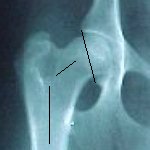
As you look at these pictures, try to imagine the angle, the smoothness
and length of femur neck and the roundness of the femoral head. Draw
two imaginary lines, one from the top rim of the acetabulaum to the outer
edge and another line depicting the angle.
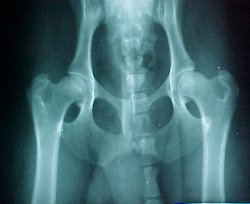 OFA EXCELLENT
OFA EXCELLENT 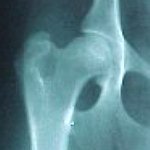
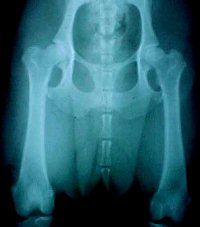 OFA GOOD
OFA GOOD 
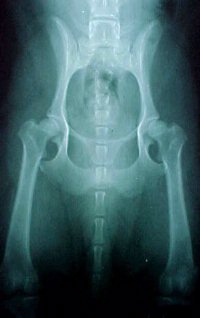 OFA FAIR
OFA FAIR 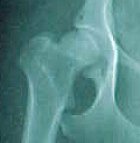
Radiographic indications of HD:
-
An increased width of the joint space
-
A flattening and deformity of the femoral head
-
A shallow acetabulum
-
Remodeling/degenerative changes of the rim of the acetabulum
-
Remodeling degenerative changes of the femoral neck
-
Subluxation.
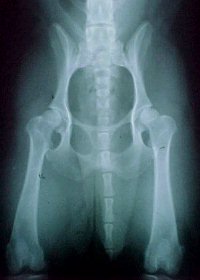 OFA MILD HD
OFA MILD HD 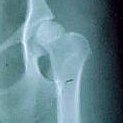
Note
-
the subluxation and the shallow acetabulum
-
the rim changes on the upper point of the acetabulum rim
-
the decreased angle of the femoral neck
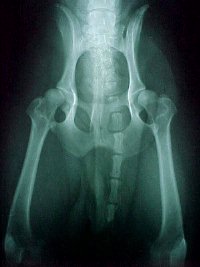 OFA MODERATE HD
OFA MODERATE HD 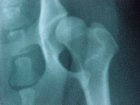
Note:
-
the remodeling of the acetabulum rim
-
the flatten somewhat mushroom femoral head
-
the thicken femoral neck.
Consider checking for Hip Dysplasia. Help establish a basis from
which we can go forward with breed improvement and avoid future problems.
For more information about OFA and to check the existing database please
visit their site www.offa.org
Reviewed By G.G. Keller, D.V.M.,M.S.,DACVR, Executive Director, Orthopedic Foundation for Animals, Inc.
BACK
 Figure
1 shows the proper positioning.
Figure
1 shows the proper positioning.
 Figure 2
A normal canine hip with the desired 130-degree angle.
Figure 2
A normal canine hip with the desired 130-degree angle.

 OFA EXCELLENT
OFA EXCELLENT 
 OFA GOOD
OFA GOOD 
 OFA FAIR
OFA FAIR 
 OFA MILD HD
OFA MILD HD 
 OFA MODERATE HD
OFA MODERATE HD 